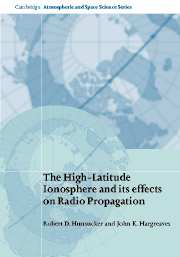Book contents
- Frontmatter
- Contents
- From the Times of London
- Preface
- Chapter 1 Basic principles of the ionosphere
- Chapter 2 Geophysical phenomena influencing the high-latitude ionosphere
- Chapter 3 Fundamentals of terrestrial radio propagation
- Chapter 4 Radio techniques for probing the ionosphere
- Chapter 5 The high-latitude F region and the trough
- Chapter 6 The aurora, the substorm, and the E region
- Chapter 7 The high-latitude D region
- Chapter 8 High-latitude radio propagation: part 1 – fundamentals and early results
- Chapter 9 High-latitude radio propagation: part 2 – modeling, prediction, and mitigation of problem
- Appendix: some books for general reading
- Index
Chapter 9 - High-latitude radio propagation: part 2 – modeling, prediction, and mitigation of problem
Published online by Cambridge University Press: 02 December 2009
- Frontmatter
- Contents
- From the Times of London
- Preface
- Chapter 1 Basic principles of the ionosphere
- Chapter 2 Geophysical phenomena influencing the high-latitude ionosphere
- Chapter 3 Fundamentals of terrestrial radio propagation
- Chapter 4 Radio techniques for probing the ionosphere
- Chapter 5 The high-latitude F region and the trough
- Chapter 6 The aurora, the substorm, and the E region
- Chapter 7 The high-latitude D region
- Chapter 8 High-latitude radio propagation: part 1 – fundamentals and early results
- Chapter 9 High-latitude radio propagation: part 2 – modeling, prediction, and mitigation of problem
- Appendix: some books for general reading
- Index
Summary
There are no such things as applied sciences, only applications of science.
Louis PasteurIntroduction
In Chapter 8 we reviewed the progress of our understanding of high-latitude radio propagation starting about 1956 when it was deemed to be a problem worth investigating, and continuing through the IGY, IGC, and IQSY international study periods until the present time. In the last 20 years we have made considerable progress in our level of understanding of the phenomena both of auroral and of polar radio propagation and there has been a “sea-change” in communications and computer technology. This forward leap in technology includes the availability of powerful, inexpensive computers and prediction/ modeling/ray-tracing software, sophisticated modulation schemes, advanced antenna theory and practice, electronic-circuit VLSI, advanced ground-based and satellite-borne geophysical sensors, and active-circuit sounding systems (see Chapter 4). This chapter will concentrate on experimental results obtained starting in the late 1980s, ionospheric modeling, ray-tracing, prediction techniques, mitigation techniques and the impact of space-weather data on ionospheric propagation.
The morphology of auroral-E (AE) propagation in the 25–30-MHz frequency range on ∼1000–2000-km paths tangential and normal to the auroral oval has been documented by Hunsucker et al. (1996) and Nishino et al. (1999).
Ionospheric ray-tracing, modeling, and prediction of propagation
Ionospheric ray-tracing
In order to make useful predictions by applying ionospheric ray-tracing programs at high latitudes, one must have an accurate model of electron-density profiles at a sufficient number of points along the propagation path.
- Type
- Chapter
- Information
- Publisher: Cambridge University PressPrint publication year: 2002



